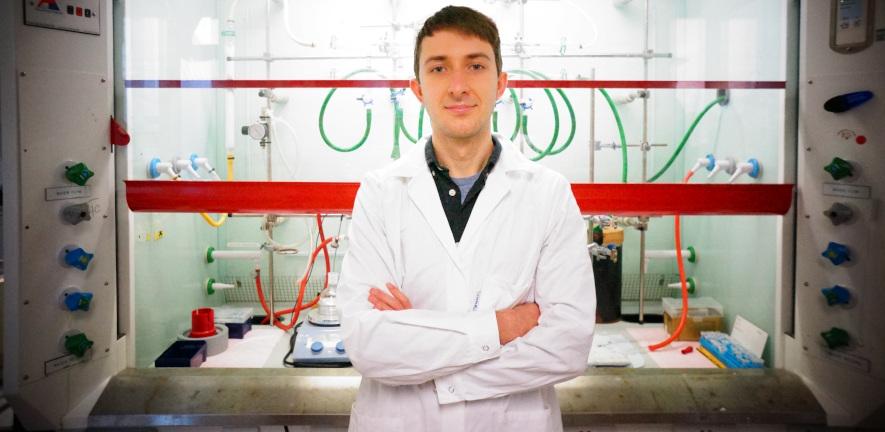
RNA controls many processes in a cell, so that even minor modifications to the RNA can determine whether a cell stays healthy or becomes cancerous.
One way to modify a cell’s RNA is to use CRISPR-Cas13, a technology often referred to as “genetic scissors,” because it can be used with extremely high precision to alter RNA. Jennifer A. Doudna and Emmanuelle Charpentier were awarded the 2020 Nobel Prize in Chemistry for the development of the CRISPR method of gene modification.
But the CRISPR technique does have some drawbacks, explains Sigitas Mikutis, a fourth year PhD student in the Bernardes group, and first author on the group’s recent paper meCLICK-Seq, a Substrate-Hijacking and RNA Degradation Strategy for the Study of RNA Methylation, published by the American Chemical Society.
“Unlike CRISPR, we can use our system directly in living cells without genetically modifying them first,” says Sigitas. CRISPR modification also requires complex biochemical machinery such as enzymes and nucleic acids, that often introduce biases. “Our technique uses only small molecules, so it is very simple and selective, and not subject to the same biases.”
RNA modification occurs naturally in living cells through several processes, of which the best understood is methylation, in which a methyl group (CH3) is appended to RNA, thereby changing its properties such as protein translation efficiency.
The researchers have for the first time devised a system which ‘hijacks’ these processes to induce selective degradation of natively methylated RNA species, by using a degrader which acts as a minimalistic enzyme to break down RNA acids. “So like scissors it cuts the RNA around the place where you would normally have the methylation – this is the position we hijack,” explains Sigitas. The group innovatively uses “click chemistry” to attach the degrader to targeted RNA.
Click chemistry is a relatively recent approach, first used in the early noughties. It describes a way of rapidly and irreversibly assembling two synthetic molecules without any by-products. These click reactions can run inside living organisms because they are relatively non-toxic and can be done at room or body temperature.
“Click chemistry was defined for the first time in 2001, and chemical biologists took a while to catch up, but it’s use has been exploding, and just a few weeks ago the first click-chemistry based therapy has entered clinical trials,” says Sigitas.
“To the best of my knowledge this is the first time that click chemistry has been applied to living cells with a measurable output that is not microscopy-based, and we can directly measure what is happening in the cells.” The group synthesises the molecules used in the click reactions themselves. “We’re trying to make the synthesis as simple as possible so they can be used across different labs.”
Sigitas believes this system could be used to create precise and easy to carry out diagnostics: “In healthy cells, all the RNA is in equilibrium, and so you expect particular species to be in certain concentrations with identifiable methylation signatures,” he says. “But in diseased cells, these methylation signatures go way off.
“With our system you can diagnose what’s happening with a particular methylation for a specific RNA species, and from there determine whether a cell is healthy or cancerous, for example. My dream is that you can draw a sample of blood, apply our technique, and then provide a clear diagnosis.”
One advantage of this new system is that it could easily be adapted to target different types of cellular systems. In addition to diagnostics, the group is now looking into more sophisticated biological applications. “We are looking at things like organ tissues, so we can compile a sort of methylation atlas across many different types of cells, and use different ways to apply our RNA degradation strategy.”
Sigitas would also like to look at using the degrader in contexts different from methylation. “So for example, acetylation is another type of RNA modification which we’re interested in. The role of acetylation is much less defined, so we’d like to establish this first.”
A C&EN article praising the research notes that it “opens the door to novel nucleic acid editing technologies” and states: “Now we finally have a very specific and efficient technology to cleave RNA on demand.”
“Having a better tool to fragment RNA will help biochemists better understand the secrets of life,” concludes Sigitas.
Research
meCLICK-Seq, a Substrate-Hijacking and RNA Degradation Strategy for the Study of RNA Methylation, Sigitas Mikutis, Muxin Gu, Erdem Sendinc, Madoka E. Hazemi, Hannah Kiely-Collins, Demetrios Aspris, George S. Vassiliou, Yang Shi, Konstantinos Tzelepis, and Gonçalo J. L. Bernardes

